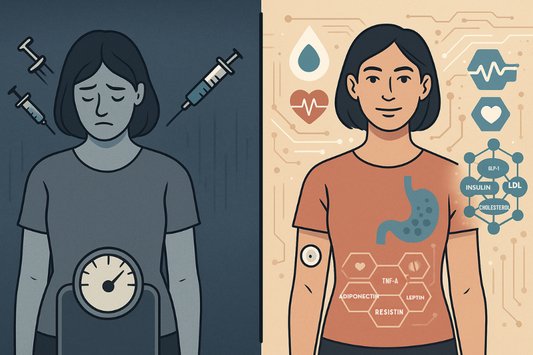Introduction
Why size really matters when it comes to cholesterol
Dementia and heart disease are not only leading causes of death in the UK, but also major contributors to reduced quality of life.
What links these to major causes of reduced health? Cholesterol levels or, more accurately, cholesterol profiles.
While there's a push for widespread use of cholesterol-lowering medication, more about that later and why you should consider it a last option, it's vital to understand that not all cholesterol is equal. Our current standard cholesterol measurement in the UK is somewhat lacking.
In this blog, I explain:
- Advanced lipid testing, focusing on key players like Apolipoprotein B (ApoB) and lipoprotein(a) to help you understand what they mean and why they matter.
- What an apolipoprotein is
- How to get a much more accurate idea of your cardiovascular health
- Why, even if you have a normal LDL, you could still have an increased risk
- Conversely, why if you have a raised LDL, you may not be at an increased, and you could, therefore, avoid medication that can have significant side effects.
Order: Advanced cholesterol home blood test: includes ApoB and Lipoprotein(a) with humanpeople

An apolipoprotein particle surrounds the yellow cholesterol.
An apolipoprotein is a type of protein that wraps around the cholesterol particle in the blood, helping it to be transported.
Cholesterol is needed to synthesise many structures and hormones in the body. As it is a fat/ oil it is hydrophobic and so needs a special carrier.
This protein allows it be transferred in the blood. The apolipoprotein coating allows it to dock at various tissues and the liver to deliver the cholesterol, which is used in making many structures, from cell walls to hormones.
Each particle has a single apolipoprotein. Read below for more details and normal ranges.
There are different types of LDL, and they have very different risks
Imagine your body as a bustling city with many different types of vehicles (lipoprotein/ cholesterol particles) traversing its streets (your blood vessels).
Now, along each street are bollards stopping vehicles from leaving the street, crashing on the pavements and causing damage.
Some vehicles are large and buoyant, like buses (large LDL particles), while others are small, zippy cars (small, dense LDL particles).
In this city, the smaller vehicles are more likely to crash between the bollards, causing damage and damage to the walls, and more cars can enter, forming a pile-up that eventually spreads onto the road and blocks it (plaque formation in arteries).
If your blood pressure is also high, it is akin to traffic moving faster and is more likely to cause damage.
Big vehicles, ie large LDL cholesterol particles, are less dangerous than small dense LDL cholesterol particles.
Traditional Cholesterol Tests: Not the Full Picture

Traditionally, we've looked at cholesterol like a traffic report that only counts total vehicles, not considering their sizes or types. We measure total cholesterol, LDL-C (low-density lipoprotein cholesterol), HDL-C (high-density lipoprotein cholesterol), and triglycerides.
But, to truly assess the risk of traffic jams (heart disease), we need to know more about the types of vehicles crowding our arterial streets.
Advanced Markers: ApoB and LAR – The Advanced Traffic Analytics
Apolipoprotein B (ApoB): The Vehicle Counter
- The counter: ApoB counts every atherogenic particle (VLDL, IDL, LDL) – each one contains an ApoB molecule, akin to counting every vehicle on the road.
- What that means: Higher ApoB levels mean more vehicles, indicating a higher risk of congestion (plaque buildup). We can also estimate the size of the vehicles using the ApoB and LDL scores.
We want less traffic AND fewer small cars. You can determine your levels from advanced testing.
Understanding your levels
Apolipoprotein A1 (ApoA1) and the good HDL cholesterol:
- This is the blood's main protein component of high-density lipoprotein (HDL).
- It plays a crucial role in cholesterol transport, particularly in removing cholesterol from tissues and its transport back to the liver for excretion.
- Higher levels of ApoA1 are generally associated with a lower risk of cardiovascular disease because of the protective role of HDL cholesterol.
- Normal Range: generally, the target range for ApoA1 is: above 1.2 g/dL for men and 1.4 g/dL for women.
Calculate your risk with advanced markers:
CardioRisk Calculator ™
2021 Canadian Lipid Guidelines
Apolipoprotein B (ApoB) and bad LDL cholesterol:
- ApoB is the main protein component of low-density lipoprotein (LDL) and very-low-density lipoprotein (VLDL).
- It is essential for lipid metabolism and is a critical player in the transport and distribution of cholesterol.
- High levels of ApoB are linked to a greater risk for cardiovascular disease since LDL contributes to plaque formation in arteries.
- Normal Range: the desirable range for ApoB is typically less than 0.9 g/dL.
ApoB/ApoA1 Ratio:
Atherogenic vs. Antiatherogenic Balance:
Apolipoprotein B (ApoB) is found in atherogenic lipoproteins (e.g., LDL, VLDL) that contribute to plaque formation in arteries.
Apolipoprotein A1 (ApoA1) is the main component of HDL, which helps remove cholesterol from the bloodstream, protecting against atherosclerosis.
A higher ApoB/ApoA1 ratio indicates a higher number of atherogenic particles relative to protective HDL particles, thus reflecting increased cardiovascular risk.
The ratio is considered a better predictor of cardiovascular events compared to traditional lipid measures such as LDL-C alone
- This ratio is considered an important marker for cardiovascular risk.
- A higher ApoB/ApoA1 ratio indicates a higher concentration of ‘bad’ cholesterol relative to ‘good’ cholesterol, suggesting a higher risk for atherosclerosis and other cardiovascular diseases.
- Risk Assessment: The ApoB/ApoA1 ratio strongly predicts cardiovascular risk, with higher ratios indicating a higher proportion of atherogenic to protective lipoproteins.
- Desirable Ratio: a lower ratio is typically better. Ratios above 0.7-0.9 for men and 0.6-0.8 for women may indicate an increased risk of cardiovascular events
Lipoprotein (a) [Lp(a)]:
- Lp(a) is a type of lipoprotein similar to LDL but with an additional protein called apolipoprotein(a).
- Elevated Lp(a) levels are an independent risk factor for cardiovascular disease.
- It is not entirely affected by lifestyle and is determined mainly by genetics.
- High Lp(a) levels can contribute to the development of atherosclerosis and increase the risk of heart attacks and strokes.
- Desirable Levels:
| Degree of Lp(a) elevation | Lp(a) levels (nmol/L) | Percentile of the population |
| Low risk | < 25 | |
| Mild risk | 25-75 | 75 |
| Moderate | 75-125 | 80-95 |
| High | 125-160 | 95-99 |
| Very high | >160 | >99 |
*Updated April 2024 to European Consensus guidelines
LDL-C/ApoB Ratio (LAR):
- LAR indicates the average size of LDL particles – a lower ratio means more small, dense LDL particles. These are the high-risk particles. A higher ratio means larger, less dangerous particles.
- Health Implications: A lower LAR (below 1.2) suggests a more significant amount of small dense particles and an increased risk of heart disease.
Making It Practical: What Does This Mean for You?
Advanced lipid measurements can unveil a more detailed picture of your cardiovascular risk, especially if traditional lipid profiles don't fully explain your heart health. Here's how to make this information actionable:
- Consult with your Doctor: Discuss the possibility of advanced lipid testing, especially if you have a family history of heart disease or inconclusive traditional lipid profiles.
- Understand Your Numbers: Know your levels of ApoB, Lp(a), ApoB1/ A1 ratio, and LAR, compare them with the standard ranges and understand what they mean for your health.
- Tailor Your Lifestyle and Treatment: Cholesterol can be managed through lifestyle in the majority of cases. Managing saturated fat levels, increasing fibre intake, exercise and supplements can all significantly impact. Your doctor might recommend specific dietary or medication changes if your LAR indicates many small, dense LDL particles.
- Regular Monitoring: Crucial if you're at high risk, regular checks can help track the effectiveness of your health strategies.
Conclusion
An advanced lipid profile offers a more nuanced cardiovascular risk assessment by analysing these specific components.
Higher ApoA1 and lower ApoB and Lp(a) levels are desirable. The ApoB/ApoA1 ratio balances harmful and protective lipoproteins, offering a more comprehensive risk assessment than traditional lipid measures.
The LAR (ratio of Apo B to total LDL-C) gives us an insight into the size of your particles, which can sometimes be missed if your LDL levels are normal.
Understanding these values can lead to more targeted and effective cardiovascular prevention and management strategies.
Order: Advanced cholesterol home blood test: includes ApoB and Lipoprotein(a) with humanpeople
References:
- Behbodikhah J, Ahmed S, Elyasi A, Kasselman LJ, De Leon J, Glass AD, Reiss AB. Apolipoprotein B and Cardiovascular Disease: Biomarker and Potential Therapeutic Target. Metabolites. 2021 Oct 8;11(10):690. doi: 10.3390/metabo11100690. PMID: 34677405; PMCID: PMC8540246.
- Bachorik PS, Lovejoy KL, Carroll MD, Johnson CL. Apolipoprotein B and AI distributions in the United States, 1988-1991: results of the National Health and Nutrition Examination Survey III (NHANES III). Clin Chem. 1997;43(12):2364-2378.
- Lampsas S, Xenou M, Oikonomou E, et al. Lipoprotein(a) in Atherosclerotic Diseases: From Pathophysiology to Diagnosis and Treatment. Molecules. 2023;28(3):969. Published 2023 Jan 18. doi:10.3390/molecules28030969
- Tsimikas S. A Test in Context: Lipoprotein(a): Diagnosis, Prognosis, Controversies, and Emerging Therapies. J Am Coll Cardiol. 2017;69(6):692-711. doi:10.1016/j.jacc.2016.11.042
- Xiao L, Zhang K, Wang F, et al. The LDL-C/ApoB ratio predicts cardiovascular and all-cause mortality in the general population. Lipids Health Dis. 2023;22(1):104. Published 2023 Jul 21. doi:10.1186/s12944-023-01869-1
- Attardo S, Musumeci O, Velardo D, Toscano A. Statins Neuromuscular Adverse Effects. Int J Mol Sci. 2022;23(15):8364. Published 2022 Jul 28. doi:10.3390/ijms23158364
- Mollazadeh H, Tavana E, Fanni G, et al. Effects of statins on mitochondrial pathways. J Cachexia Sarcopenia Muscle. 2021;12(2):237-251. doi:10.1002/jcsm.12654
- Ruhaak LR, Cobbaert CM. Quantifying apolipoprotein(a) in the era of proteoforms and precision medicine. Clin Chim Acta. 2020;511:260-268. doi:10.1016/j.cca.2020.10.010
- Ward A, Crean S, Mercaldi CJ, et al. Prevalence of apolipoprotein E4 genotype and homozygotes (APOE e4/4) among patients diagnosed with Alzheimer's disease: a systematic review and meta-analysis. Neuroepidemiology. 2012;38(1):1-17. doi:10.1159/000334607
- Florian Kronenberg, Samia Mora, Erik S G Stroes, Brian A Ference, Benoit J Arsenault, Lars Berglund, Marc R Dweck, Marlys Koschinsky, Gilles Lambert, François Mach, Catherine J McNeal, Patrick M Moriarty, Pradeep Natarajan, Børge G Nordestgaard, Klaus G Parhofer, Salim S Virani, Arnold von Eckardstein, Gerald F Watts, Jane K Stock, Kausik K Ray, Lale S Tokgözoğlu, Alberico L Catapano, Lipoprotein(a) in atherosclerotic cardiovascular disease and aortic stenosis: a European Atherosclerosis Society consensus statement, European Heart Journal, Volume 43, Issue 39, 14 October 2022, Pages 3925–3946,






